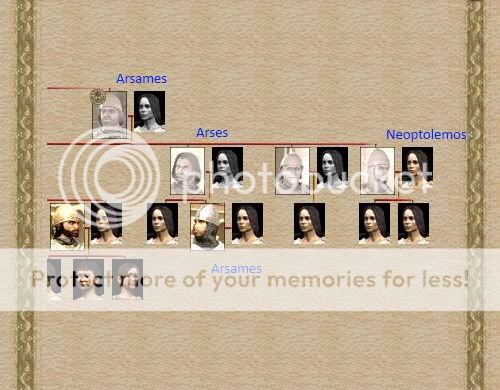In 186 BC the kingdom of Epeiros had landed a small army near the Pontic port of Halikarnassos. The army then marched through Pontic territory until it reached the island of Lesbos, where it was soon joined by a second landing force. This was a clear and blatant violation of the treaty of 257 BC between Ariobarzanes Kianos and the great Pyrrhos of Epeiros (see Chapter 11: Negotiating with Pyrrhos), whereby Epeiros would hold sway over all lands to the west of the Hellespont, while Pontos laid claim to all lands to the east - including those such as Lesbos which were previously held by Makedonia, at least according to the Pontic interpretation of the treaty. What's more, the Epeirote army was also devastating the very limited farmland available on Lesbos.
The governor of Mytilene at this time was Arsames Kianos. Eager to counter the rumors about his lack of personal courage, Arsames pre-emptively attacked the two Epeirote armies, wiping them out but also triggering a state of war between Pontos and Epeiros.
Across the Hellespont, the Greek colonists in Byzantion chose this moment to throw off their Getai rulers and declare their allegiance to the Koinon Hellenon. Seeing the great advantage that such a buffer state would provide to Pontos in any future war against Epeiros, Arsames immediately sent a diplomat to negotiate an alliance with the Byzantines. Pontos now sided with the Koinon Hellenon against the Epeirotes and Makedonians.
All these events were a mere sideshow to the great conflict unfolding far to the southwest, in the lands of Carthage. First, the Carthaginians had sent an army deep into their old territory, to try once again to retake Lepki. Opposing them was Megabazos son of Zenon. His father had taken the Pontic army further north, forcing Megabazos to raise a mercenary army supported by local Numidian cavalry to lift the siege of Lepki. This was to be their first real test.
As the battle lines clashed, it was hard to tell who was fighting who, since both sides were using mercenaries. However, only Megabazos had hired phalangites, and these stood firm against the onslaught of two Carthaginian generals. When the Carthaginian leader fell to the sell-swords, the Carthaginian army dissolved into a rout, only to be mercilessly hunted down by the swift Numidian horsemen.
Further to the north, Zenon had been resting and refitting his army in Adrumeto, but was himself besieged by a second Carthaginian army. Zenon ordered an immediate sally, trusting that his veteran klerouchoi phalangites could hold the center of the line against elite Libyan pikemen.

The two great armies formed up and faced each other outside the walls of Adrumeto. Zenon soon won the battle of the skirmishers, as his Cretan archers decimated the native light troops sent out to counter them. But then the two lines of heavy infantry clashed, and for a long time there was no clear winner. Finally Zenon led his cavalry behind Carthaginian lines, sending his steppe riders on ahead to pin the Carthaginian leader, and following up with a crushing charge by his own bodyguards. Once again a Carthaginian army lost its general and immediately dissolved into a rout, but this time there was a worse fate than to be stabbed in the back by a Numidian lance, for Zenon let his scythed chariots loose on the routers, cutting down all in front of them.
The Carthaginians had taken a great gamble, sending almost all of their troops in the two armies to fight Zenon and his son - and they had lost. Now Zenon would not give them a second chance. Taking the best men from his army, he marched out and laid siege to Kart-Hadast, which was defended by just a handful of elite Carthaginian troops.
The Carthaginians did not have enough men to defend the vast walls of Carthage, and so chose to stay in the central square. As the Pontic phalanx moved through the streets to challenge them, they were met by a hail of javelins, followed by an all-out charge of the cream of Phoenicia, Libya, and Iberia. The elites were better man-for-man, but the Pontic troops stood firm - and soon a second Pontic phalanx crashed into the rear of the Carthaginians. They fought bravely to the last, but the outcome was never in any real doubt.
Zenon ordered the population of Kart-Hadast put to the sword, seeking to humble this once-mighty empire, but he almost immediately regretted the decision. Not by nature a selfish man, this act of wanton violence went against his very nature, and it is said that he was forevermore plagued by nightmares of the days of violence that followed the capture of Kart-Hadast.

One benefit of the slaughter of Kart-Hadast was that Pontic spies now found it very easy to convince the citizens of neighboring Atiqa that it was in their own interests to open the gates of their city to Zenon. "Zenon the butcher", the spies called him, and they spread rumors of his bloodthirstiness throughout Atiqa. A lot of exaggeration and a little gold soon sufficed to open the gates, and a small Pontic force stormed through. Again, there were far too few Carthaginian defenders to do anything other than make a desperate last stand on the square, and Machimoi infantry from far-off Egypt were only to happy to send them to their maker. Atiqa fell a few weeks after Kart-Hadast, and the spies kept their word, for Zenon did not slaughter its inhabitants - instead, he sold half of them into slavery.
Carthago Delenda Est.

Bookmarks